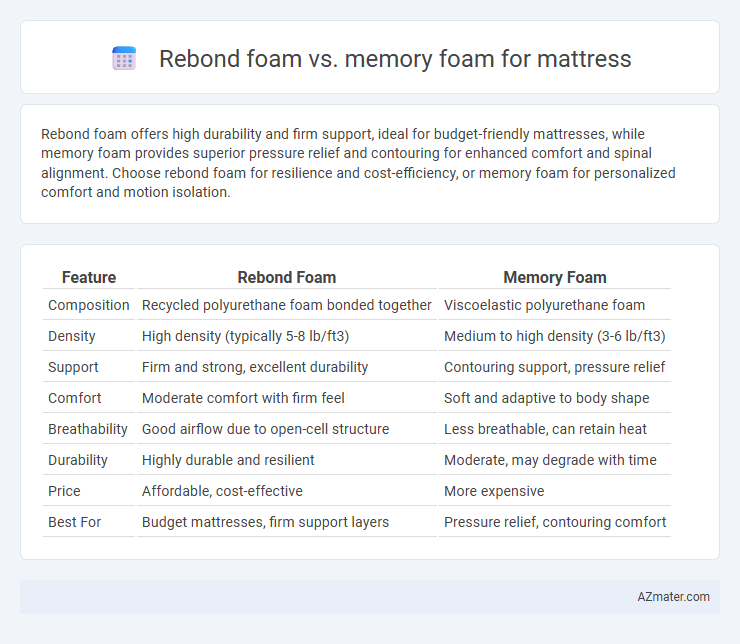Rebond foam offers high durability and firm support, ideal for budget-friendly mattresses, while memory foam provides superior pressure relief and contouring for enhanced comfort and spinal alignment. Choose rebond foam for resilience and cost-efficiency, or memory foam for personalized comfort and motion isolation.
Table of Comparison
| Feature | Rebond Foam | Memory Foam |
|---|---|---|
| Composition | Recycled polyurethane foam bonded together | Viscoelastic polyurethane foam |
| Density | High density (typically 5-8 lb/ft3) | Medium to high density (3-6 lb/ft3) |
| Support | Firm and strong, excellent durability | Contouring support, pressure relief |
| Comfort | Moderate comfort with firm feel | Soft and adaptive to body shape |
| Breathability | Good airflow due to open-cell structure | Less breathable, can retain heat |
| Durability | Highly durable and resilient | Moderate, may degrade with time |
| Price | Affordable, cost-effective | More expensive |
| Best For | Budget mattresses, firm support layers | Pressure relief, contouring comfort |
Introduction to Rebond Foam and Memory Foam
Rebond foam is made by shredding and compressing scrap foam to create a dense, durable mattress material known for its firm support and breathability. Memory foam, derived from viscoelastic polyurethane, contours closely to the body's shape, providing pressure relief and motion isolation for enhanced comfort. Comparing these foams highlights the trade-off between rebound foam's resilient support and memory foam's adaptive cushioning.
Key Differences Between Rebond Foam and Memory Foam
Rebond foam consists of shredded foam pieces bonded together, offering high density and firm support ideal for durability and resilience, whereas memory foam is a viscoelastic material that contours closely to the body for pressure relief and enhanced comfort. Rebond foam provides better breathability and is typically more affordable, while memory foam excels in motion isolation and heat retention properties. Mattress buyers prioritize rebound foam for firm support and longevity, while memory foam suits those seeking body contouring and pressure point alleviation.
Construction and Material Composition
Rebond foam mattress cores are made by shredding and compressing recycled foam pieces, primarily polyurethane, resulting in a dense, supportive structure with high resilience and durability. Memory foam, composed of viscoelastic polyurethane with added chemicals to enhance viscosity and density, features an open-cell structure that conforms closely to body contours, providing pressure relief and motion isolation. The manufacturing processes and material formulations of rebond foam emphasize firmness and bounce, while memory foam prioritizes contouring comfort and heat retention due to its viscoelastic properties.
Comfort and Support Comparison
Rebond foam offers firm, supportive cushioning by compressing shredded foam pieces, making it ideal for people who prefer a dense and resilient mattress base. Memory foam contours closely to the body, providing pressure relief and enhanced comfort through its slow response to heat and weight, which aids in reducing joint pain and improving sleep posture. While rebond foam excels in durability and support, memory foam is favored for its superior comfort and ability to distribute body weight evenly.
Durability and Longevity
Rebond foam is highly durable due to its composition of shredded foam pieces bonded together, offering strong resistance to wear and tear over time. Memory foam, while providing superior pressure relief and contouring, tends to degrade faster with frequent use, losing its shape and support within 3-5 years. For mattresses prioritizing longevity, rebond foam generally outperforms memory foam in maintaining firmness and structural integrity over extended periods.
Temperature Regulation and Breathability
Rebond foam offers superior breathability due to its open-cell structure, which allows for enhanced air circulation and effective temperature regulation, keeping sleepers cooler throughout the night. In contrast, memory foam tends to retain heat because of its dense composition, often leading to a warmer sleep environment. Choosing rebond foam can be beneficial for those prone to overheating or seeking a mattress with improved ventilation and moisture-wicking properties.
Motion Isolation and Noise Reduction
Rebond foam offers moderate motion isolation and minimal noise, making it suitable for budget-friendly mattresses with a balance of support and movement absorption. Memory foam excels in motion isolation by contouring to body shape and absorbing vibrations, thus significantly reducing partner disturbance during sleep. Noise reduction is superior in memory foam due to its dense, viscoelastic structure, while rebond foam tends to be noisier because of its compressed polyurethane foam particles.
Suitability for Different Sleeping Positions
Rebond foam provides firm support ideal for stomach sleepers who need a stable surface to maintain spinal alignment, while memory foam contours closely to the body, making it perfect for side sleepers by relieving pressure on hips and shoulders. Back sleepers benefit equally from memory foam's ability to cradle the lumbar region, whereas rebond foam offers a more resilient base that prevents sinkage. Choosing between rebond and memory foam depends on the sleeper's position preference and the level of pressure relief or support required for optimal comfort.
Price Comparison and Value for Money
Rebond foam mattresses typically offer a lower price point compared to memory foam, making them an affordable option for budget-conscious buyers. Memory foam provides superior pressure relief and contouring properties, often resulting in better long-term comfort and durability. When evaluating value for money, memory foam mattresses justify higher costs with enhanced support and durability, while rebond foam serves well for temporary or low-budget needs.
Which Foam is Best for Your Mattress?
Rebond foam, made from shredded polyurethane foam bonded together, offers firm support and high durability, making it ideal for budget-friendly mattresses and users needing strong edge support. Memory foam contours to the body's shape by responding to heat and pressure, providing superior pressure relief and motion isolation, best suited for individuals with joint pain or who prefer a softer, more adaptive mattress. The best choice depends on personal comfort preferences, support needs, and sleeping position, with memory foam favored for comfort and rebond foam chosen for affordable firmness and longevity.

Infographic: Rebond foam vs Memory foam for Mattress
 azmater.com
azmater.com